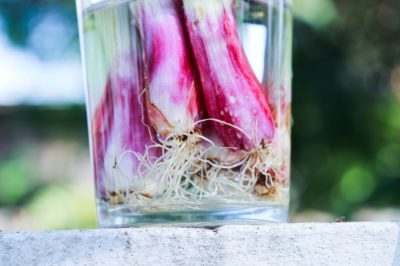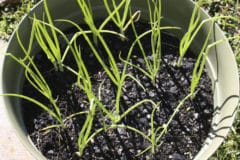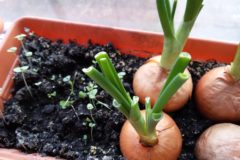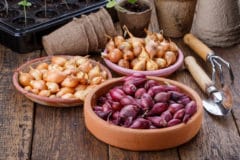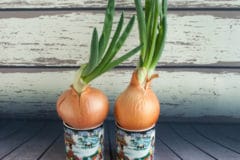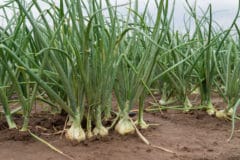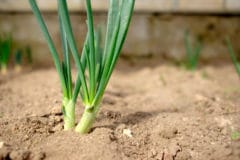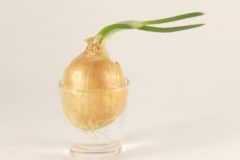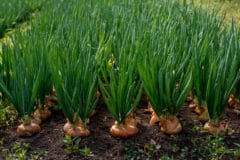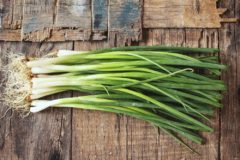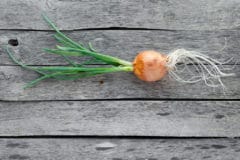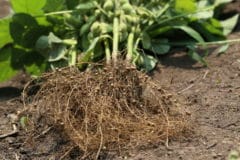Regrowing Scallions in Nothing but Water
This is the easiest, read laziest, way to regrow scallions. All you need is the root ends from a bundle of scallions; a small vase, jar, or glass; and water, no hydroponic growing formula that you have to mix, just water. Here are the arduous steps you will need to take:
- When you cut the roots off of your scallions, leave at least 1/2 inch to 1 inch of the stem.
- Place the roots and stems in your container.
- This part is really difficult. Make sure that all of the roots are pointed down, and all of the stems are pointed up.
- This is really difficult, too. Fill your glass with enough water to cover the roots and bulb with the leaf end above the water line.
- You will need to tax your brain to choose a sunny location for your container of scallions. Scallions need six to seven hours of light each day. If you don’t have a sufficiently sunny location, use a grow light or a cool, white fluorescent bulb. If you need to use artificial light for your scallions, make sure that your containers are all the same height so that you can place the light an equal distance above the leaves of all of your plants.
- Every few days, whenever the water in the container meets the highly technical term of “murky”, you will need to replace the murky water with fresh, clear water.
- Now, for the most arduous part of regrowing your scallions, other than changing the water, you must just simply wait the seven to 10 days that it will take for the leaves of the scallions to grow to a respectable enough length that you can begin to use them as seasonings and garnishes. That’s a really tough one.
Several clear glass vases or jars of scallions with visible roots growing on a sunny window sill make an attractive display for a kitchen or breakfast nook. The leaves also are in easy reach for harvesting and use.
You can begin snipping off the leaves for seasoning or garnishes when they are about the length of your palm. If you keep your scallions in the jar of water, constantly producing shoots without replenishing food sources from the soil and leaves will eventually drain the bulb of nourishment. At that point, it will stop producing new shoots.
If you like, though, when the leaves are just two to three inches long, you can transplant them into a pot or outdoors into your garden. When planted in the ground, your bulbs will keep producing shoots throughout the growing season. If your scallions bolt, or produce flowers, you can use the flowers in salads.
Regrowing Scallions in Soil
If you just can’t quite adjust to the idea that you can grow your scallions in nothing but water, you can regrow them in soil.
- If you want to grow your scallions in a pot, use a potting soil mix blended for vegetables or vegetables and herbs. Top soil is too heavy for container gardening.
- Your container should be at least 6 inches deep and as wide as your space allows. Make sure that it has a sufficient number of holes in the bottom to allow for adequate drainage. You can be creative with your choice of containers, but if you use something like a plastic bucket, you will need to drill holes in the bottom and sides.
- When planting your scallions in a container, fill the container half full with the potting soil, and space your scallions 2 inches apart. The root end should be down and the leaf end should be up.
- When transplanting your scallions to your garden, space them 2 inches apart in rows that are at least 12 inches apart.
- Cover the bulbs with soil until just the top tip of the bulb is showing, and then water. If the soil settles and allows the bulbs to show, cover the bulbs with more soil.
- If you are growing your scallions in containers indoors, choose a sunny location or use artificial light as described above.
You can begin trimming the leaves for seasonings and garnishes in about two weeks.
Other Veggies You Can Regrow
You can try this regrowing method with shallots, pearl onions, garlic, and lettuce, kale, and celery hearts among others.
You can create attractive salad planters for yourself or to give as gifts by mixing the contrasting leaf shapes and textures of scallions, loose leaf lettuce, and radishes.
At the end of the growing season, try creating your own onion sets using the same drying method that you would use with shallots to create shallot sets.
